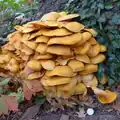Omphalotus illudens
Omphalotus illudens, commonly known as the eastern jack-o'lantern mushroom, is a large, orange mushroom that is often found in clumps on decaying stumps, buried roots, or at the base of hardwood trees in eastern North America. Its gills often exhibit a weak green bioluminescence when fresh. This green glow has been mentioned in several journal articles, which state that the phenomenon can persist up to 40–50 hours after the mushroom has been picked.[1] It is believed that this display serves to attract insects to the mushroom's gills during nighttime, which can then distribute its spores across a wider area.[2]
| Omphalotus illudens | |
|---|---|
 | |
| Scientific classification | |
| Domain: | Eukaryota |
| Kingdom: | Fungi |
| Division: | Basidiomycota |
| Class: | Agaricomycetes |
| Order: | Agaricales |
| Family: | Omphalotaceae |
| Genus: | Omphalotus |
| Species: | O. illudens |
| Binomial name | |
| Omphalotus illudens (Schwein.) Bresinsky & Besl | |
| Omphalotus illudens | |
|---|---|
| Gills on hymenium | |
| Cap is infundibuliform | |
| Hymenium is decurrent | |
| Stipe is bare | |
| Spore print is yellow | |
| Ecology is saprotrophic | |
| Edibility is poisonous | |
Omphalotus illudens is sometimes confused with edible chanterelles, but can be distinguished by its thicker, fleshier appearance, tendency to form large clusters, and clearly separated caps when young. Unlike chanterelles, the Eastern jack-o'-lantern is poisonous to humans when eaten, whether raw or cooked, and typically causes vomiting, cramps, and diarrhea. Although some older literature claims the name is synonymous with Omphalotus olearius, phylogenetic analysis confirms the two as distinct species.[3]
Toxicity
The poisonous chemical compounds illudin S and illudin M were isolated from Omphalotus illudens.[4][5] In addition to their antibacterial and antifungal effects, illudins appear to be the cause of human toxicity when these mushrooms are eaten raw or cooked. Muscarine has also been indirectly implicated in toxicity,[6] but modern studies to demonstrate its presence in O. illudens are needed.
The cytotoxic effect of illudin is of interest for treating some cancers, but illudin itself is too poisonous to use directly so it must first be chemically modified. Inside human cells, illudin S reacts with DNA and creates a type of DNA damage that blocks transcription. This block can only be relieved by a repair system called nucleotide excision repair. Damage in non-transcribed DNA areas is left unrepaired by the cell. This property was exploited by the company MGI Pharma to develop an illudin-derivative called Irofulven for use as a cancer treatment. Its application is still in the experimental phase.[7]
Gallery
_Bresinsky_%2526_Besl_1018098506.jpg.webp)
_Bresinsky_%2526_Besl_190464.jpg.webp)
_Bresinsky_%2526_Besl_270109.jpg.webp)
_Bresinsky_%2526_Besl_248346.jpg.webp)
_Bresinsky_%2526_Besl_268693.jpg.webp)
 Jack o' lantern mushroom fungus with U.S. quarter for size reference and cap underside shown lower right.
Jack o' lantern mushroom fungus with U.S. quarter for size reference and cap underside shown lower right. Jack o' lantern mushroom fungus clusters growing at the base of an oak tree.
Jack o' lantern mushroom fungus clusters growing at the base of an oak tree. Jack o' lantern mushrooms glowing bioluminescence, also showing artificial light photo for reference.
Jack o' lantern mushrooms glowing bioluminescence, also showing artificial light photo for reference.
References
- Vanden Hoek, Todd, L.; Erickson, Timothy; Hryborczuk, Daniel; Narasimhan, Kris (May 1991). "Jack O'Lantern Mushroom Poisoning". Annals of Emergency Medicine. 20 (5): 559–561. doi:10.1016/S0196-0644(05)81617-8. PMID 2024797.
{{cite journal}}: CS1 maint: multiple names: authors list (link) - Oliveira, Anderson, G.; Stevani, Cassius, V.; Waldenmeier, Hans, E.; Viviani, Vadim; Emerson, Jillian, M.; Loros, Jennifer, J.; Dunlap, Jay, C. (March 2015). "Circadian Control Sheds Light on Fungal Bioluminescence". Current Biology. 25 (7): 964–8. doi:10.1016/j.cub.2015.02.021. PMC 4382382. PMID 25802150.
{{cite journal}}: CS1 maint: multiple names: authors list (link) - Kirchmair M, Morandell S, Stolz D, Pöder R, Sturmbauer C (2004). "Phylogeny of the genus Omphalotus based on nuclear ribosomal DNA-sequences" (PDF). Mycologia. 96 (6): 1253–60. doi:10.2307/3762142. JSTOR 3762142. PMID 21148949. Retrieved 2010-05-26.
- Anchel, M.; Herbey, A.; Robbins, W.J. (1950). "Antibiotic Substances from Basidiomycetes: VII. Clitocybe illudens". Proceedings of the National Academy of Sciences of the United States of America. 36 (5): 300–305. Bibcode:1950PNAS...36..300A. doi:10.1073/pnas.36.5.300. PMC 1063187. PMID 15417544.
- McMorris, T. C.; Kelner, M. J.; Wang, W.; Estes, L. A.; Montoya, M. A.; Taetle, R. (1992). "Structure-Activity Relationship of Illudins : Analogs with Improved Therapeutic Index". Journal of Organic Chemistry. 57 (25): 6876–6883. doi:10.1021/jo00051a037.
- Clark, Ernest D.; Smith, Clayton S. (1913). "Toxicological Studies on the Mushrooms Clitocybe illudens and Inocybe infida". Mycologia. 5 (4): 224–232. doi:10.2307/3753387. JSTOR 3753387.
- National Center for Biotechnology Information. "PubChem Compound Summary for CID 148189, Irofulven" PubChem, https://pubchem.ncbi.nlm.nih.gov/compound/Irofulven . Accessed 16 October, 2020.